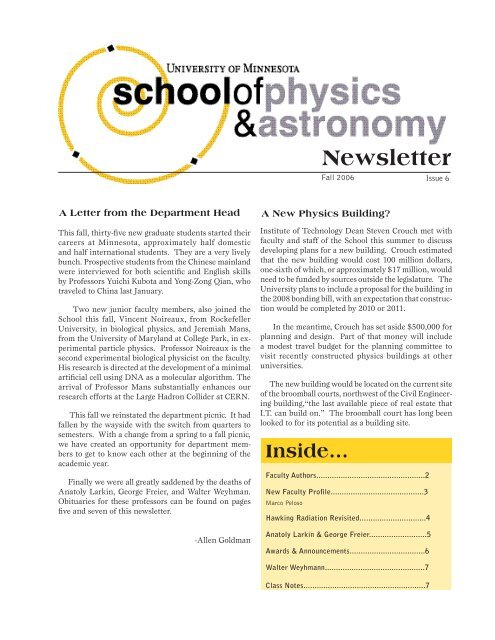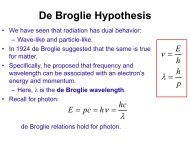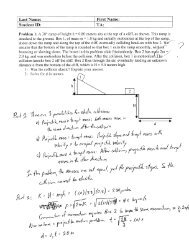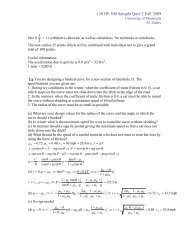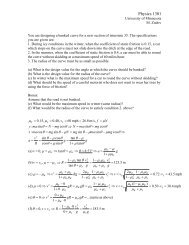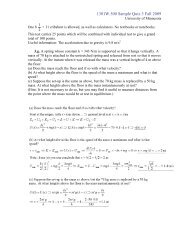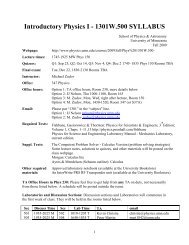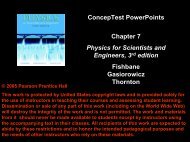Newsletter - School of Physics and Astronomy - University of ...
Newsletter - School of Physics and Astronomy - University of ...
Newsletter - School of Physics and Astronomy - University of ...
Create successful ePaper yourself
Turn your PDF publications into a flip-book with our unique Google optimized e-Paper software.
Anatoly LarkinPhoto by Tom FoleyPr<strong>of</strong>essor Anatoly Larkin<strong>of</strong> the <strong>School</strong> <strong>of</strong> <strong>Physics</strong> <strong>and</strong><strong>Astronomy</strong> died on ThursdayAugust 4, 2005 in Aspen, Colorado.Pr<strong>of</strong>essor Larkin was72. Larkin had been attendinga physics workshop when hedied unexpectedly.Larkin joined the FineTheoretical <strong>Physics</strong> InstituteAnatoly Larkin, (FTPI) at the <strong>University</strong> <strong>of</strong>1932-2005Minnesota in 1995 after along <strong>and</strong> prestigious career in his native Russia. Hewas a condensed matter theorist, specializing in superconductivity.His research also was key to the study <strong>of</strong>one-dimensional systems <strong>and</strong> clusters that are so familiarin the fields <strong>of</strong> nanoscience <strong>and</strong> nanotechnology.Larkin was a leader <strong>of</strong> a renowned Russian school <strong>of</strong>theoretical physics. Many <strong>of</strong> his former students holdleading academic positions at universities <strong>and</strong> institutesboth in Russia <strong>and</strong> the Western world. He was a recipient<strong>of</strong> many awards, including the Hewlett Packard EurophysicsPrize, A Humboldt Award, the London Prizein Low Temperature <strong>Physics</strong>, the Lars Onsager Prize inTheoretical Statistical <strong>Physics</strong> <strong>and</strong> the Bardeen Prize forSuperconductivity.Larkin published more than 50 papers during his 10years at the <strong>School</strong>, as well as the 600-page “Theory <strong>of</strong>Fluctuations in Superconductors. “Anatoly Larkin was agiant in the field <strong>of</strong> condensed matter theory <strong>and</strong> a greatteacher <strong>of</strong> theoretical physicists,” said Allen Goldman,head <strong>of</strong> the <strong>School</strong> <strong>of</strong> <strong>Physics</strong> <strong>and</strong> <strong>Astronomy</strong>.Larkin was born Oct. 14, 1932, near Moscow. Hestarted his career as a researcher at the Moscow PhysicalEngineering Institute, <strong>and</strong> went on to positions at theL<strong>and</strong>au Institute for Theoretical <strong>Physics</strong> <strong>and</strong> MoscowState <strong>University</strong>.Larkin is survived by his wife Tatiana; his sons Victor<strong>and</strong> Ivan; his daughters in-law Marina <strong>and</strong> Victoria;his gr<strong>and</strong>children Alex<strong>and</strong>er, Maria, Ilia, Anatoly <strong>and</strong>Timothy; <strong>and</strong> great-gr<strong>and</strong>children S<strong>of</strong>ia <strong>and</strong> George.Larkin was cremated <strong>and</strong> his ashes taken by his familyback for funeral services in Russia, which were heldon Friday, August 19, 2005. FTPI plans to dedicate itsspring workshop in condensed matter physics to thememory <strong>and</strong> research <strong>of</strong> Pr<strong>of</strong>essor Larkin.George FreierContributed by Pr<strong>of</strong>. C. J. WaddingtonGeorge Freier, Pr<strong>of</strong>essorEmeritus <strong>of</strong><strong>Physics</strong>, died onFriday May 18th,2005, at the age <strong>of</strong>90. George was bornin Ellsworth, Wisconsinon the familyfarm <strong>and</strong> frequentlyGeorge Freier, 1915-2005 described the harshlife on a farm in the early days <strong>of</strong> the last century. Hegraduated from River Falls State Teachers College in1938 <strong>and</strong> taught in White Lake, Wisconsin until WW II.He received a Master <strong>of</strong> Arts degree from the <strong>University</strong><strong>of</strong> Minnesota in 1941 <strong>and</strong> then worked in the NavalOrdnance Laboratory from 1942 to 1944, developingtorpedoes. Returning to the <strong>University</strong> he was awardeda Ph.D. in nuclear physics in 1949, <strong>and</strong> was appointedan assistant pr<strong>of</strong>essor in the same year. His studies withthe nuclear physics group led to a number <strong>of</strong> importantdiscoveries about the behavior <strong>of</strong> nuclear interactions atlow energies. In particular he was the first to demonstratethe production <strong>of</strong> polarized beams <strong>of</strong> nucleons. He waspromoted to full pr<strong>of</strong>essor in 1958 at about the time thathis interests switched to atmospheric physics.His work with the high voltages <strong>of</strong> the <strong>University</strong> V<strong>and</strong>e Graaff accelerator led to his interest in thunderstorms<strong>and</strong> the electrical discharges that produced lightning.He switched his research work from nuclear physicsto meteorology <strong>and</strong> this remained the main topic <strong>of</strong> hisresearch for the rest <strong>of</strong> his career. After discovering thatrain drops were <strong>of</strong>ten radioactive he developed a theory<strong>of</strong> rain drop formation in which the radioactive atomslead to the nucleation <strong>of</strong> water vapor to form drops. Usingsimple but clever instruments he monitored every thunderstormthat occurred in the area, rushing to the ro<strong>of</strong><strong>of</strong> the <strong>Physics</strong> building every time a storm approached.He made a point <strong>of</strong> collecting all the folk weather lorethat he could find <strong>and</strong> wrote a popular book, WeatherProverbs that discussed the basis <strong>and</strong> validity <strong>of</strong> all <strong>of</strong>the proverbs <strong>and</strong> weather related sayings he had found.He also had a lifelong interest in the theory <strong>and</strong> practice<strong>of</strong> music, building a number <strong>of</strong> string instruments <strong>and</strong>studying Newton’s work on musical theory.George was deeply committed to teaching <strong>and</strong> believedthat the concepts <strong>and</strong> ideas <strong>of</strong> physics were bestcommunicated by h<strong>and</strong>s-on demonstrations. His “DemonstrationH<strong>and</strong>book for <strong>Physics</strong>” co-written with F. J.Anderson, was used in many universities. In 2002, thePhoto by ??Continued on Page 85
Awards <strong>and</strong> AnnouncementsVainshtein to Receive Pomeranchuk Prize<strong>School</strong> <strong>of</strong> <strong>Physics</strong> <strong>and</strong> <strong>Astronomy</strong> Pr<strong>of</strong>essor<strong>and</strong> member <strong>of</strong> the Fine Theoretical<strong>Physics</strong> Institute Arkady Vainshteinwill receive the 2005 PomeranchukPrize in theoretical physics.Vainshtein will share the prize withhis collaborator, Iosif Khriplovich <strong>of</strong>Vainshteinthe Budker Institute for Nuclear <strong>Physics</strong>in Novosibirsk, Russia. The prizecommittee cited Vainshtein <strong>and</strong> Khriplovich for their“outst<strong>and</strong>ing contribution to underst<strong>and</strong>ing the properties<strong>of</strong> the st<strong>and</strong>ard model, especially for illuminatingwork on weak <strong>and</strong> strong interaction <strong>of</strong> quarks.”This prize, awarded by the Institute <strong>of</strong> Theoretical <strong>and</strong>Experimental <strong>Physics</strong> (ITEP), is intended to perpetuatethe memory <strong>of</strong> Isaak Yakovlevich Pomeranchuk, the famoustheoretical physicist known for work in many fields.Previous winners <strong>of</strong> the Pomeranchuk Prize, awardedannually since 1998, include S. Drell, J. D. Bjorken, T.Regge, <strong>and</strong> F. Dyson.Rudnick Receives Outst<strong>and</strong>ing Community ServiceRudnickDahlberg Receives George Taylor AwardDahlbergCourtesy <strong>of</strong> <strong>Physics</strong> ForceCourtesy <strong>of</strong> Rudnick John Lind PhotographyPeloso Receives Best Instructor Award<strong>School</strong> <strong>of</strong> <strong>Physics</strong> <strong>and</strong> <strong>Astronomy</strong>Pr<strong>of</strong>essor Marco Peloso received a 2005Institute <strong>of</strong> Technology (IT) Best Pr<strong>of</strong>essorAward at an IT Week award ceremony.Peloso was chosen by an e-mailsurvey <strong>of</strong> all Institute <strong>of</strong> Technologyundergraduates as the Best InstructorPeloso in the <strong>Physics</strong> Department.6Photo by J. AllanPr<strong>of</strong>essor Larry Rudnick <strong>of</strong> the <strong>School</strong><strong>of</strong> <strong>Physics</strong> <strong>and</strong> <strong>Astronomy</strong> received a2005 <strong>University</strong> <strong>of</strong> Minnesota Outst<strong>and</strong>ingCommunity Service Award.Rudnick received the award in part forcontributions to the Science Works!Program, the Minneapolis Planetarium<strong>and</strong> DragonflyTV.Pr<strong>of</strong>essor Dan Dahlberg <strong>of</strong> the <strong>School</strong><strong>of</strong> <strong>Physics</strong> <strong>and</strong> <strong>Astronomy</strong> received theGeorge Taylor Distinguished ServiceAward. Dahlberg <strong>and</strong> Larry Rudnick(see previous article) were recognizedformally at the Institute <strong>of</strong> TechnologyPre-Commencement celebration.2004 Student AwardsLeft to right front row: Ardis Nier, Jennifer Dockter,Kay Blair, Jooho Park. Second row: David Toyli,Elizabeth Barnes, Yousi Ma, Tomo Matsumura, PeanutMcCoy. Back row: Derek Lee, Greg McKusky, KyleZilic, Erik Aver.Mrs. Ardis Nier presented the Alfred O. C. Nier Award<strong>and</strong> Mrs. Kay Blair attended on behalf <strong>of</strong> the J. MorrisBlair Award.RecipientOur Development OfficerJennifer PaynePogatchnikPhoto by Tom FoleyAwardElizabeth A. Barnes Alfred O.C. NierDavid M. ToyliHarry & Viola St. CyrPaul R. ShearerJ. Morris BlairKyle T. ZilicJeffrey BasfordYousi MaThe Hagstrum AwardTomotake Matsumura Aneesur Rahman AwardJooho ParkAneesur Rahman AwardErik J. AverOutst<strong>and</strong>ing TA AwardJennifer L. Docktor Outst<strong>and</strong>ing TA AwardDerek M. LeeOutst<strong>and</strong>ing TA AwardBradley “Peanut” McCoy Outst<strong>and</strong>ing TA AwardGregory M. McKusky Outst<strong>and</strong>ing TA AwardXiaoxia PengOutst<strong>and</strong>ing TA AwardJennifer Payne Pogatchnik612-626-9501or jpogatchnik@it.umn.edu.P l a n s a n d q u e s t io n sregarding making gifts tothe department will be keptconfidential. In addition,Jennifer can insure yourwishes are carried out <strong>and</strong>that a plan is in place foryour gift today <strong>and</strong> into the
Walter WeyhmannClass NotesPr<strong>of</strong>essor Emeritus Walter V.Weyhmann, 69, died on Saturday,September 24, 2005.Pr<strong>of</strong>essor Weyhmann, a graduate<strong>of</strong> Duke <strong>University</strong>, Class <strong>of</strong> ‘57,Weyhmann received his Ph.D. from Harvard<strong>University</strong> in 1963. He came to the<strong>University</strong> in 1964 as an Assistant Pr<strong>of</strong>essor.Pr<strong>of</strong>essor Weyhmann made important contributionsto the area <strong>of</strong> experimental low temperature physics includingpioneering techniques in nuclear cooling whichenabled the study <strong>of</strong> the properties <strong>of</strong> real materials inmK <strong>and</strong> sub-mK temperature range <strong>and</strong> the discovery<strong>of</strong> nuclear magnetic ordering PrCu 6. The latter was thefirst observation <strong>of</strong> nuclear magnetic ordering in a metallicsystem. PrCu 6is unusual, characterizerized by veryweak coupling <strong>of</strong> its nuclear <strong>and</strong> electronic spin systems.Its magnetic ordering is dominated by the nuclear spinsystem. Pr<strong>of</strong>essor Weyhmann’s breakthrough with thismaterial opened the door for much research in this <strong>and</strong>similar directions.Pr<strong>of</strong>essor Allen Goldman, praised Weyhmann’s abilitiesas a teacher saying that his lectures were known fortheir clarity <strong>and</strong> completeness. He called him a pioneerat Minnesota in the way in which he taught thermal<strong>and</strong> stasistical physics using more physical <strong>and</strong> underst<strong>and</strong>ableexamples than had been traditionally used inthose subjects.Pr<strong>of</strong>essor Weyhmann was promoted quickly to AssociatePr<strong>of</strong>essor in 1968 <strong>and</strong> Full Pr<strong>of</strong>essor in 1975. Heserved as Head <strong>of</strong> the <strong>School</strong> for 7 years (1975-82) <strong>and</strong>Acting Head for one year (1973-74). He was appointedAssociate Dean <strong>of</strong> the Graduate <strong>School</strong> for Research in1989 <strong>and</strong> continued in this position until 1993. He alsoserved as Acting Dean <strong>of</strong> the Graduate <strong>School</strong> for twoquarters during this period. Pr<strong>of</strong>essor Weyhmann retiredin 2001, but continued his research activities in his subbasementlaboratory until about a year ago.Pr<strong>of</strong>essor Weyhmann is survived by his wife, Rose;daughter, Elizabeth (Brian) Freeberg; gr<strong>and</strong>children,Michael, Anna, Darryl <strong>and</strong> Peter; sister, Anita (Victor)Brugh; brother-in-law, Chester (Mona Jean) Fossee;several nieces <strong>and</strong> nephews.Hassib Amini (Ph.D. ‘03) is currently working as aSenior Engineer at Seagate Technolgy in Bloomington,Minnesota.Jennifer Anderson (B.S. ’98) recently completed aPh.D. in Geology at Brown <strong>University</strong> <strong>and</strong> returned toMinnesota with her husb<strong>and</strong>, fellow alumnus JeremyAnderson, for a fellowship at Carleton College.Jennifer Blue (Ph.D. ‘97) is starting a tenure-track positionat Miami <strong>University</strong> in Oxford, Ohio this fall.Heather Brown (Ph. D. ‘03) <strong>and</strong> Steve Wilkins (B.S.’96) were married in October 2004. Brown is workingat General Atomics in San Diego <strong>and</strong> Wilkins is workingat the Genomics Institute <strong>of</strong> the Novartis ResearchFoundation in San Diego.Luke Corwin (B.S. ’03) is currently a graduate studentat The Ohio State <strong>University</strong>. Corwin is working in theOSU BaBar group under Pr<strong>of</strong>. Klaus Honscheid. Thisfall he will move to Stanford Linear Accelerator Center,which houses BaBar, to continue pursuing his Ph.D..Phil Dudero (B.S. 1985) has returned to the departmentto pursue a Ph.D. in <strong>Physics</strong>. He married recently <strong>and</strong>he <strong>and</strong> his wife live in married housing on campus.Jesse Johnson (B.S. ’94) is currently an Assistant Pr<strong>of</strong>essor<strong>of</strong> Computer Science at the <strong>University</strong> <strong>of</strong> Montana atMissoula. After completing his Bachelors at Minnesotahe spent three years in Malawi as a Peace Corps Volunteer.He received a Ph.D. in <strong>Physics</strong> <strong>and</strong> a Masters inComputer Science from the <strong>University</strong> <strong>of</strong> Maine. He ismarried with two children.David Kleinjan (B.S. ‘04) works designing fire sprinklersfor Viking Automatic Sprinkler Company in St.Paul. He is planning to go to graduate school in 2006.Earl Kyle (B. S. ’61) currently a consultant <strong>and</strong> volunteerfor NASA’s Solar System Ambassador Program. Kyleis a former military/aerospace engineer/physicist whosedesigns have flown on Apollo manned moon missions,Skylab, Orbiting Solar Observatory, Delta rockets, <strong>and</strong>the SR-71 Blackbird. He has also served as a consultantfor numerous aerospace corporations as well as on theSenate Space Shuttle Advisory Committee.Dave Madl<strong>and</strong> (Ph.D. ‘70) recently retired from 30years in the nuclear physics group in the TheoreticalDivision at Los Alamos. His work included fission stud-Continued on Page 87
Class Notes continued from Page 7Freier continued from Page 5ies, optical potentials, Hauser-Feshbach calculations, <strong>and</strong>the use <strong>of</strong> the Dirac equation in scattering <strong>and</strong> nuclearstructure (relativistic mean field) studies. He was namedan APS Fellow in 2003.Christian Minor (B.A. ‘94) currently a Senior Staff Scientistfor Nova Research, Inc. <strong>of</strong> Alex<strong>and</strong>ria, Virginia <strong>and</strong>works as an in-house contractor for the Naval ResearchLaboratory, Washington, D.C.James McLinn (M.S. ’74) is a Senior Reliability Engineerat Teradyne Instruments. McLinn is a Fellow<strong>of</strong> the American Society for Quality <strong>and</strong> was namedDistinguished Engineer in Minnesota in 2000 by theMinnesota Federation <strong>of</strong> Engineering Societies.Jeff Nelson (Ph.D. ‘94) is an Assistant Pr<strong>of</strong>essor at TheCollege <strong>of</strong> William & Mary in Williamsburg, VA.Elwood Nestvold (Ph.D. ‘62) retired from ShellGroupin 1992. Since his retirement he has formed a consultingcompany in Oil <strong>and</strong> Gas Exploration <strong>and</strong> Productionwhose clients have included Schlumberger, IBM, YPF(Argentina), <strong>and</strong> Japex (Japan).<strong>University</strong> named the demonstration room in the TateLaboratory <strong>of</strong> <strong>Physics</strong> as the George D. Freier LectureDemonstration Room in recognition <strong>of</strong> his work. Hewas honored by a Distinguished Service Citation fromthe American Association <strong>of</strong> <strong>Physics</strong> Teachers for hisservices to undergraduate teaching.George retired from the <strong>University</strong> in 1985, whenhe reached the m<strong>and</strong>atory retirement age <strong>of</strong> 70. He waspreceded in death by his wife, Phyllis, who was also aPr<strong>of</strong>essor <strong>of</strong> <strong>Physics</strong> at the <strong>University</strong>. He is survivedby his son, David <strong>and</strong> daughter Susan, as well as threegr<strong>and</strong> children.Cover Illustration fromDemonstration News, anewsletter which Freierstarted to keep facultyabreast <strong>of</strong> the latestdemonstrations. Freierdid all the illustrationsfor the newsletter aswell as his H<strong>and</strong>book.This whimsical character<strong>of</strong>ten appeared in hisdrawings.<strong>Newsletter</strong>Allen M. GoldmanHead, <strong>School</strong> <strong>of</strong> <strong>Physics</strong> & <strong>Astronomy</strong>Send article suggestions <strong>and</strong> additions/deletions for thenewsletter mailing list to:Jenny AllanEditor<strong>School</strong> <strong>of</strong> <strong>Physics</strong> & <strong>Astronomy</strong><strong>University</strong> <strong>of</strong> Minnesota116 Church Street S.E.Minneapolis, MN 55455jenny@physics.umn.eduThe opinions expressed in this newsletter do not necessarily reflect the <strong>of</strong>ficial policies<strong>of</strong> the Board <strong>of</strong> Regents or the <strong>University</strong> administrationThe <strong>University</strong> <strong>of</strong> Minnesota is committed to the policy that all persons shall haveequal access to its programs, facilities, <strong>and</strong> employment without regard to race, color,creed, religion, national origin, sex, age, marital status, disability, public assistancestatus, veteran status, or sexual orientation.To:


